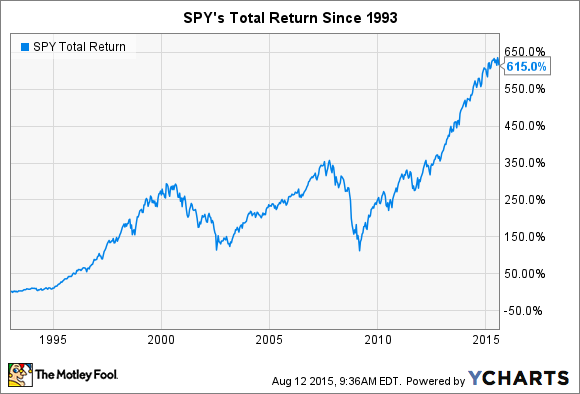[ad_1]
Last week, in the still-recent wake of Facebook’s epic one-day fall and Apple’s unprecedented milestone of $1 trillion in market capitalization, we looked at the impact a single—and massive—company can have on a passive ETF.
Specifically, we looked at the SPDR S&P 500 ETF Trust (SPY), a market-cap-weighted ETF that invests in the companies comprising the S&P 500 Index. As we well know, in this fund, the so-called FAANGs—Facebook, Apple, Amazon, Netflix and Google (now Alphabet)—carry significant weight as a result of their market capitalization alone. These are huge companies, and together they represent nearly 15% of the portfolio.
Any sharp moves in these companies’ stock prices can have a significant impact on SPY’s performance by design, or on any ETF that tracks the S&P 500 in a market-cap-weighted portfolio, such as the iShares Core S&P 500 ETF (IVV) and the Vanguard S&P 500 ETF (VOO).
Beyond Market Cap
So, we talked about an alternative. If you’re an ETF investor looking for passive access to the S&P 500 index, SPY is only one of your choices.
The biggest ETF competing with SPY, but with a smart-beta twist, is the Invesco S&P 500 Equal Weight ETF (RSP). By equal-weighting the portfolio of S&P 500 stocks, RSP minimizes some of the impact the largest companies can have on the fund’s performance, while offering more exposure to the smaller-cap companies included in the index.
In RSP, the FAANGs represent only about 2% of the overall mix. The top 10 holdings in the portfolio account for just under 3% of the overall mix. In SPY, the top 10 represent almost 22% of the portfolio.
SPY Upside Down
There’s more. Another choice is a relatively young ETF that came to market last October, offering a very unusual take on the S&P 500, the Reverse Cap Weighted U.S. Large Cap ETF (RVRS).
RVRS literally turns the S&P 500 Index upside down, assigning the most weight to the smallest companies, and the least weight to those with the largest market capitalization. FAANGs here carry a negligible representation, as in less than 1% in combined allocation. Meanwhile, the top 10 holdings (comprising the smallest companies in the index) account for about 6.6 %.
“It’s ‘small minus big’ size premium factor exposure within large-cap,” said Phil Bak, head of Exponential ETFs. “Much of the size-factor literature says that the size premium is substantial, but that small-cap valuations have some issues due to less liquidity and analyst coverage. Keeping the size bet within large-cap solves that problem.”

Sources: ETF.com, FactSet data
When The Approach Works
RVRS works great when small-caps lead the way in terms of performance, and when momentum gives way to value—trends Bak says are beginning to take shape. But so far this year, the notable rise of mega caps like Netflix, Amazon and Google, to name a few, has benefited market-cap funds, no doubt. RVRS has yet to catch up to SPY and even to equal-weighted RSP, as one would expect.

Chart courtesy of StockCharts.com
Long Menu Of Choices
The good news is that if plain-vanilla market cap isn’t for you, or if going upside down and betting on the smaller companies instead, or even taking the middle road and equal-weighting don’t meet your goals, the ETF market has plenty more to offer.
There are numerous ETFs that pick their stocks from the S&P 500 universe. Several break it up by factor, focusing on value, growth, quality, momentum, volatility or even dividends in the S&P 500 space.
There’s a high-beta version, for example, in the Invesco S&P 500 High Beta ETF (SPHB), which is a bullish bet on 100 companies in the S&P 500 with the highest beta.
SPHB has a low-vol counterpart that invests in the 100 least volatile S&P 500 stocks, the Invesco S&P 500 Low Volatility ETF (SPLV). You can express very bullish views or take the low-vol road within S&P 500 securities. And look at how disperse their results can be:

Chart courtesy of StockCharts.com
Chart courtesy of StockCharts.com
There’s even an ESG flavor of S&P 500 access in the Global X S&P 500 Catholic Values ETF (CATH) as well as strategies that go to another level of complexity by adding an options overlay, such as the Horizons S&P 500 Covered Call ETF (HSPX). HSPX tracks the S&P 500 and writes calls against the S&P 500 stocks to earn a premium.
And that’s to say nothing of leverage and inverse S&P 500 ETFs. The list goes on.
Thanks to the easy-to-access ETF wrapper, you can choose many takes on the same universe of stocks, from strategies as plain vanilla as a market-cap-weighted portfolio of S&P 500 stocks to funds with as many bells and whistles as you can possibly imagine. The question is, what are you trying to achieve? And, of course, due diligence anyone?
Contact Cinthia Murphy at [email protected]
[ad_2]
Source link

